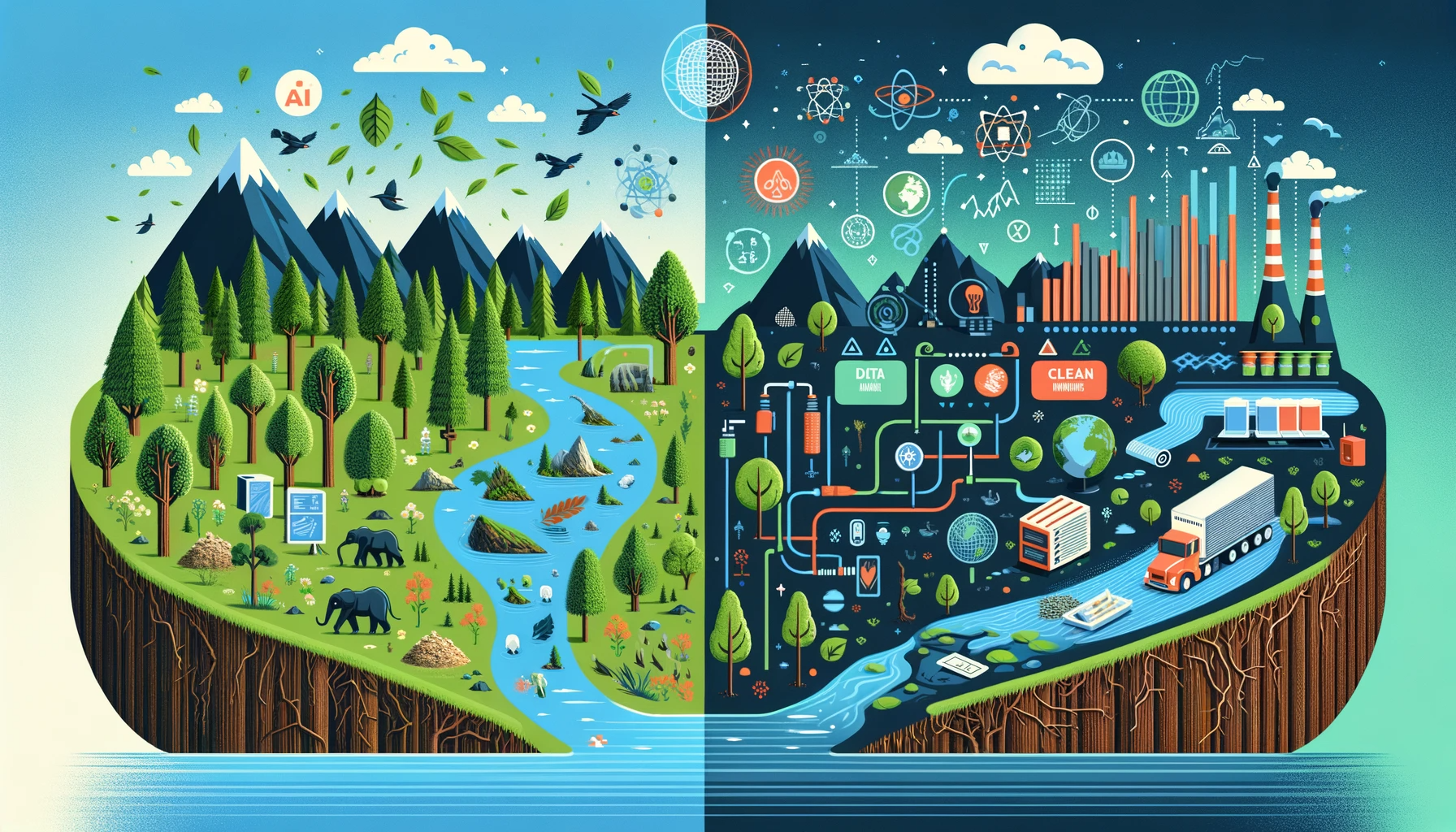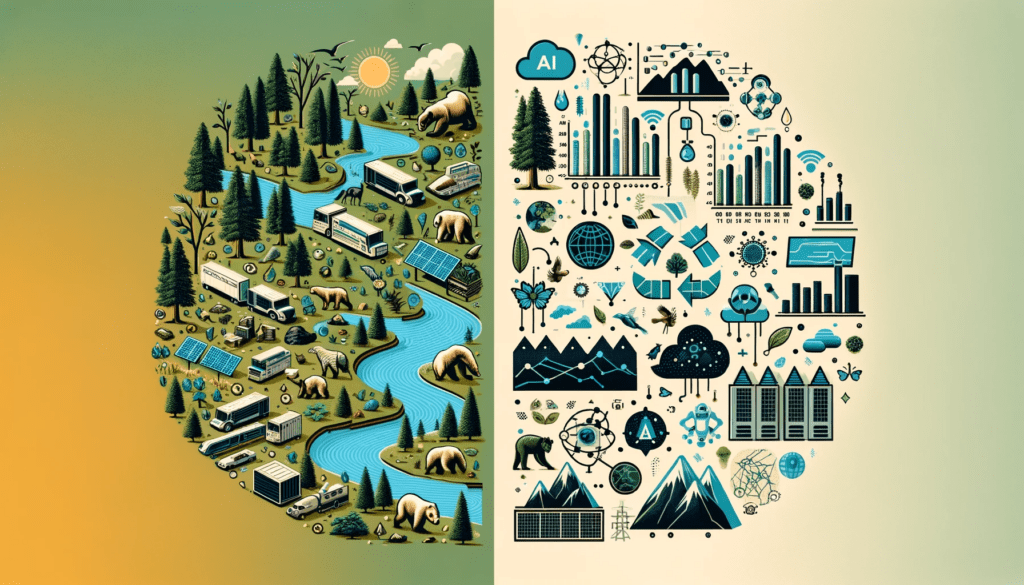Artificial Intelligence (AI) has emerged as a transformative force across various industries, promising innovation, efficiency, and convenience. However, with its rapid proliferation, the question of whether AI is a boon or a bane for the environment has gained prominence. This article explores the multifaceted impact of AI on the environment, addressing both its potential benefits and environmental challenges.
In recent years, AI has witnessed unprecedented growth, enabling machines to mimic human intelligence, learn from data, and make autonomous decisions. Its applications range from autonomous vehicles and healthcare diagnostics to natural language processing and predictive analytics. While these advancements hold promise for addressing complex global challenges, such as climate change and resource management, they also come with a significant environmental footprint.
Understanding AI’s Environmental Impact:
To assess whether AI is a boon or bane for the environment, it is crucial to understand the extent of its environmental impact. AI’s carbon footprint primarily stems from two sources: data centers and the training of machine learning models.
Data centers, the backbone of AI infrastructure, consume vast amounts of electricity to power servers and maintain optimal operating conditions. These centers generate substantial heat, necessitating additional energy for cooling systems. The global network of data centers is estimated to consume over 200 terawatt-hours (TWh) of electricity annually, surpassing the energy consumption of entire countries.
Moreover, AI model training, a resource-intensive process, demands significant computational power. Deep learning models, particularly those used in natural language processing and image recognition, require extensive training on high-performance GPUs (Graphics Processing Units) or TPUs (Tensor Processing Units). This process consumes substantial energy and contributes to the overall carbon footprint of AI.
Despite these environmental challenges, AI also offers the potential to mitigate environmental issues. For instance, AI-driven climate models can enhance our understanding of climate change, aiding in more accurate predictions and informed policy decisions. AI algorithms can optimize energy usage in smart grids, reduce emissions in transportation through autonomous vehicles, and aid in precision agriculture to optimize resource utilization.
AI’s Role in Environmental Conservation:
One of AI’s most promising roles in environmental conservation lies in its ability to monitor and protect wildlife and natural ecosystems. AI-powered camera traps, equipped with image recognition algorithms, can identify and track endangered species, providing invaluable data for conservation efforts. Additionally, AI-driven acoustic monitoring can detect and analyze animal sounds, aiding in the conservation of biodiversity.
AI is also instrumental in climate modeling and prediction. Advanced AI models can analyze vast datasets of climate data, enabling more accurate climate predictions and simulations. This information is indispensable for understanding the impacts of climate change and developing strategies to mitigate its effects.
Furthermore, AI contributes to sustainable resource management. In agriculture, AI-powered precision farming techniques optimize the use of water, fertilizers, and pesticides, reducing environmental pollution and conserving resources. In forestry, AI can analyze satellite imagery to detect illegal logging and deforestation, supporting efforts to protect vital ecosystems.
While AI’s environmental potential is evident, it is essential to acknowledge that realizing these benefits requires responsible development and ethical considerations. Striking a balance between AI’s advantages and its environmental footprint is crucial in determining whether AI is a boon or bane for the environment.

The Dark Side of AI’s Environmental Impact:
While AI holds great promise for environmental conservation, it also presents a dark side with significant environmental challenges. One of the foremost concerns is the energy-intensive nature of AI, particularly during the training of machine learning models. As AI applications become more complex and data-intensive, the computational power required for training these models escalates.
Deep learning models, which are widely used in AI applications, are notorious for their high computational demands. Training these models involves performing numerous calculations on massive datasets, often requiring powerful GPUs or TPUs. These hardware components consume substantial amounts of electricity and generate heat, necessitating additional energy for cooling. Consequently, data centers hosting AI infrastructure contribute significantly to carbon emissions.
To put this into perspective, a single training run of a large language model like GPT-3 can have a carbon footprint equivalent to driving a car for thousands of miles. The energy consumed during AI model training can rival the energy usage of entire households for months. As AI technologies become more pervasive, their cumulative energy demand poses a considerable environmental challenge.
Another concern is electronic waste or e-waste. AI-driven devices and electronics have shorter lifespans due to rapid technological advancements. This leads to a higher turnover of electronic devices, resulting in increased e-waste. Improper disposal of e-waste can lead to environmental contamination and health hazards due to toxic components like lead and mercury found in electronic devices.
Additionally, AI’s reliance on vast datasets can lead to privacy concerns. Gathering, storing, and analyzing large amounts of data, often without proper data governance, can result in the violation of individual privacy rights. The ethical and legal dimensions of data usage in AI have raised questions about responsible AI development and its implications for data security.
Efforts Towards Sustainable AI:
Recognizing the environmental challenges posed by AI, various stakeholders are actively working towards making AI more sustainable and eco-friendly. Several initiatives and strategies are being employed to reduce AI’s carbon footprint and mitigate its environmental impact.
- Energy-Efficient Algorithms: Researchers are developing energy-efficient AI algorithms that require fewer computational resources for model training and inference. These algorithms aim to strike a balance between AI performance and energy consumption.
- Renewable Energy Usage: Data centers that host AI infrastructure are increasingly transitioning to renewable energy sources such as solar and wind power. This shift helps reduce the carbon footprint of AI operations.
- Edge Computing: Edge AI, where AI processing is performed on local devices rather than centralized data centers, reduces the need for extensive data center operations and minimizes energy consumption.
- Responsible Data Management: Implementing ethical and secure data management practices ensures that AI developers use data responsibly and comply with privacy regulations, reducing data-related environmental risks.
- E-Waste Recycling: Efforts to recycle and responsibly dispose of electronic waste are gaining momentum. Some AI manufacturers are also designing products with longevity and recyclability in mind.
- Regulations and Standards: Governments and organizations are working on establishing regulations and standards for sustainable AI development, encompassing energy efficiency, data privacy, and responsible electronic waste management.
Balancing the Scales: AI’s Pros and Cons for the Environment:
Balancing the scales of AI’s environmental impact requires a comprehensive approach that considers both its advantages and drawbacks. The key lies in responsible AI development and the conscious adoption of sustainable practices.
AI’s potential to revolutionize environmental conservation, climate modeling, resource management, and sustainability cannot be overlooked. However, the energy-intensive nature of AI, coupled with concerns about electronic waste and data privacy, necessitates careful consideration.
The ultimate verdict on whether AI is a boon or a bane for the environment depends on how well we manage its environmental impact. It is incumbent upon AI developers, organizations, governments, and individuals to prioritize sustainable AI practices, promote energy efficiency, and ensure responsible data usage. The future of AI and the environment hinges on our ability to strike this delicate balance.

Conclusion:
In the quest to determine whether AI is a boon or a bane for the environment, we find a nuanced and complex relationship. AI holds the potential to play a significant role in addressing pressing environmental challenges, from climate change to wildlife conservation and resource management. However, its environmental impact, characterized by energy-intensive operations and electronic waste, poses substantial challenges.
Efforts are underway to make AI more sustainable, from developing energy-efficient algorithms to adopting renewable energy sources and implementing responsible data management practices. The path forward involves a delicate balancing act, where we harness the benefits of AI for the environment while mitigating its adverse effects.
Ultimately, the verdict on AI’s impact on the environment depends on our collective commitment to responsible AI development and sustainability. As technology continues to evolve, it is imperative that we prioritize the well-being of our planet, ensuring that AI becomes a genuine boon for environmental conservation rather than a bane.
